2007 CHEVROLET EXPRESS CARGO VAN Rear axle
[x] Cancel search: Rear axlePage 278 of 458
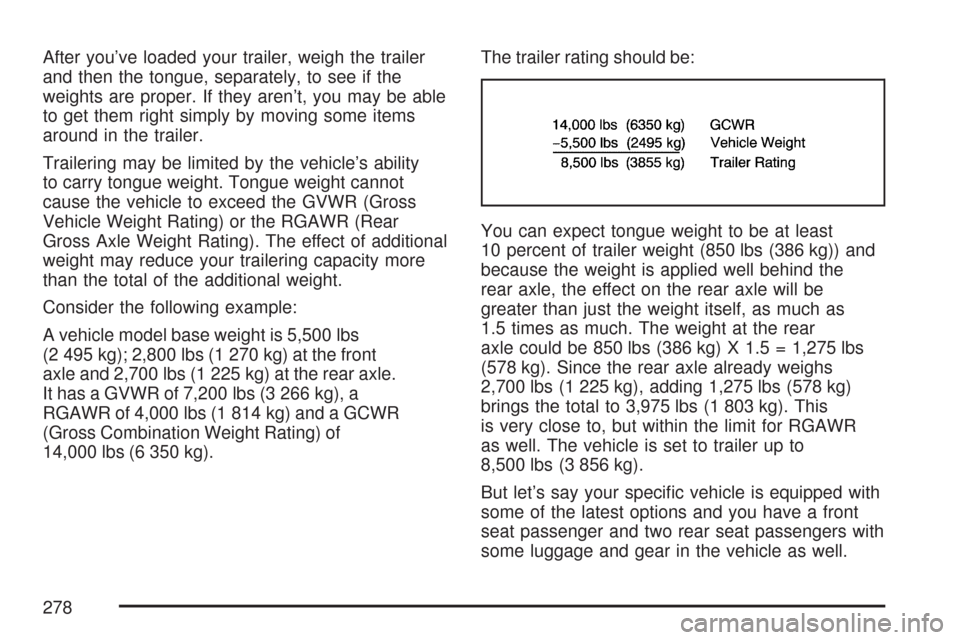
After you’ve loaded your trailer, weigh the trailer
and then the tongue, separately, to see if the
weights are proper. If they aren’t, you may be able
to get them right simply by moving some items
around in the trailer.
Trailering may be limited by the vehicle’s ability
to carry tongue weight. Tongue weight cannot
cause the vehicle to exceed the GVWR (Gross
Vehicle Weight Rating) or the RGAWR (Rear
Gross Axle Weight Rating). The effect of additional
weight may reduce your trailering capacity more
than the total of the additional weight.
Consider the following example:
A vehicle model base weight is 5,500 lbs
(2 495 kg); 2,800 lbs (1 270 kg) at the front
axle and 2,700 lbs (1 225 kg) at the rear axle.
It has a GVWR of 7,200 lbs (3 266 kg), a
RGAWR of 4,000 lbs (1 814 kg) and a GCWR
(Gross Combination Weight Rating) of
14,000 lbs (6 350 kg).The trailer rating should be:
You can expect tongue weight to be at least
10 percent of trailer weight (850 lbs (386 kg)) and
because the weight is applied well behind the
rear axle, the effect on the rear axle will be
greater than just the weight itself, as much as
1.5 times as much. The weight at the rear
axle could be 850 lbs (386 kg) X 1.5 = 1,275 lbs
(578 kg). Since the rear axle already weighs
2,700 lbs (1 225 kg), adding 1,275 lbs (578 kg)
brings the total to 3,975 lbs (1 803 kg). This
is very close to, but within the limit for RGAWR
as well. The vehicle is set to trailer up to
8,500 lbs (3 856 kg).
But let’s say your specific vehicle is equipped with
some of the latest options and you have a front
seat passenger and two rear seat passengers with
some luggage and gear in the vehicle as well.
278
Page 279 of 458

You may add 300 lbs (136 kg) to the front axle
weight and 400 lbs (181 kg) to the rear axle
weight. Your vehicle now weighs:
Weight is still below 7,200 lbs (3 266 kg) and you
may think that you should subtract 700 additional
pounds (318 kg) from your trailering capacity to
stay within GCWR limits. Your maximum trailer
would only be 7,800 lbs (3 538 kg). You may go
further and think you must limit tongue weight to
less than 1,000 lbs (454 kg) to avoid exceeding
GVWR. But, you must still consider the effect on therear axle. Because your rear axle now weighs
3,100 lbs (1 406 kg), you can only put 900 lbs
(408 kg) on the rear axle without exceeding
RGAWR. The effect of tongue weight is about
1.5 times the actual weight. Dividing the 900 lbs
(408 kg) by 1.5 leaves you with being able to
handle only 600 lbs (272 kg) of tongue weight.
Since tongue weight is usually at least 10 percent of
total loaded trailer weight, you can expect that the
largest trailer your vehicle can properly handle is
6,000 lbs (2 721 kg).
It is important that you make sure your vehicle
does not exceed any of its ratings — GCWR,
GVWR, RGAWR, Maximum Trailer Rating
or Tongue Weight. The only way to be sure you
are not exceeding any of these ratings is to weigh
your vehicle and trailer.
279
Page 280 of 458
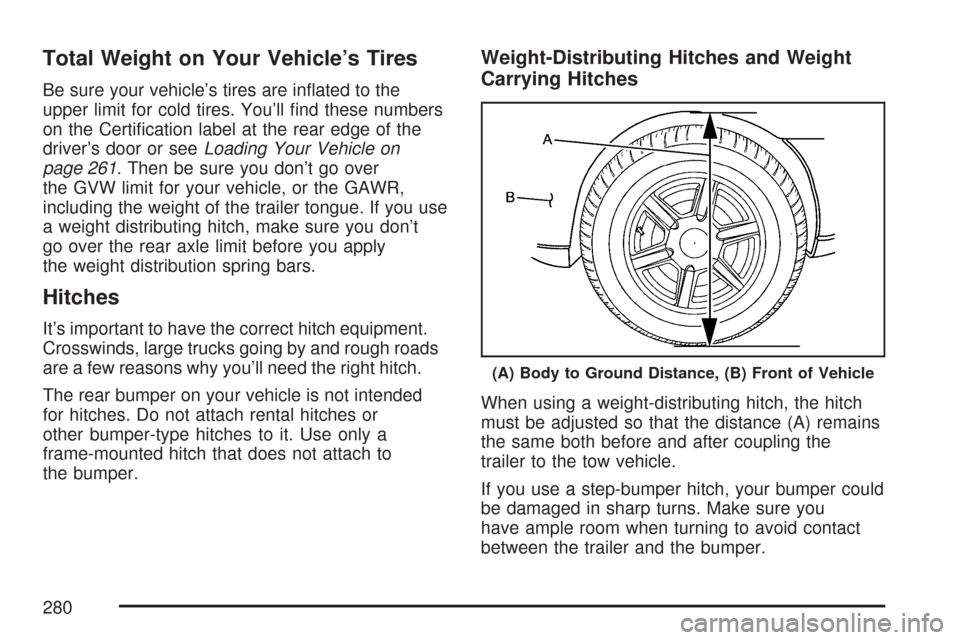
Total Weight on Your Vehicle’s Tires
Be sure your vehicle’s tires are inflated to the
upper limit for cold tires. You’ll find these numbers
on the Certification label at the rear edge of the
driver’s door or seeLoading Your Vehicle on
page 261. Then be sure you don’t go over
the GVW limit for your vehicle, or the GAWR,
including the weight of the trailer tongue. If you use
a weight distributing hitch, make sure you don’t
go over the rear axle limit before you apply
the weight distribution spring bars.
Hitches
It’s important to have the correct hitch equipment.
Crosswinds, large trucks going by and rough roads
are a few reasons why you’ll need the right hitch.
The rear bumper on your vehicle is not intended
for hitches. Do not attach rental hitches or
other bumper-type hitches to it. Use only a
frame-mounted hitch that does not attach to
the bumper.
Weight-Distributing Hitches and Weight
Carrying Hitches
When using a weight-distributing hitch, the hitch
must be adjusted so that the distance (A) remains
the same both before and after coupling the
trailer to the tow vehicle.
If you use a step-bumper hitch, your bumper could
be damaged in sharp turns. Make sure you
have ample room when turning to avoid contact
between the trailer and the bumper.
(A) Body to Ground Distance, (B) Front of Vehicle
280
Page 286 of 458
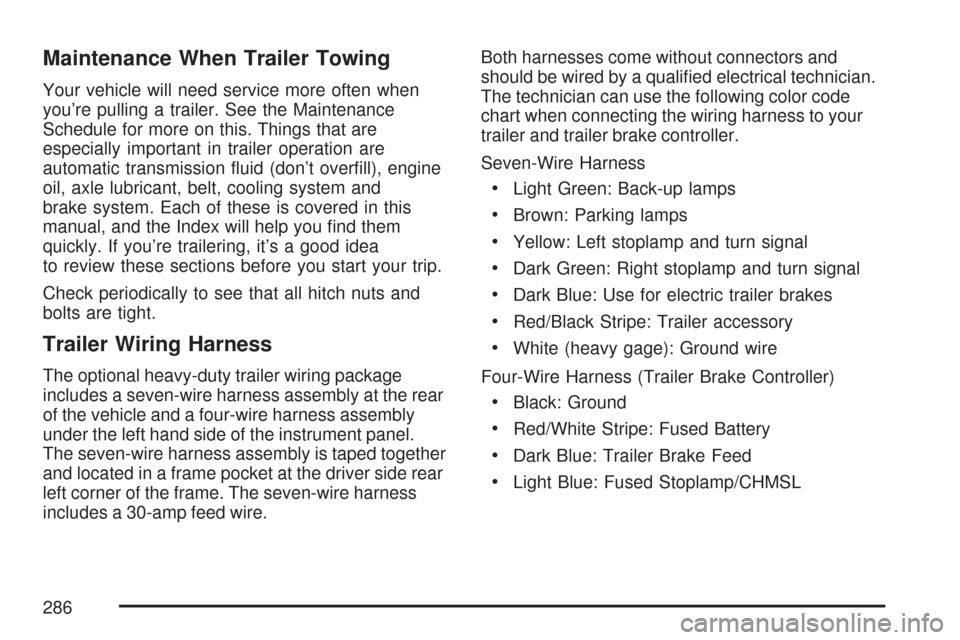
Maintenance When Trailer Towing
Your vehicle will need service more often when
you’re pulling a trailer. See the Maintenance
Schedule for more on this. Things that are
especially important in trailer operation are
automatic transmission fluid (don’t overfill), engine
oil, axle lubricant, belt, cooling system and
brake system. Each of these is covered in this
manual, and the Index will help you find them
quickly. If you’re trailering, it’s a good idea
to review these sections before you start your trip.
Check periodically to see that all hitch nuts and
bolts are tight.
Trailer Wiring Harness
The optional heavy-duty trailer wiring package
includes a seven-wire harness assembly at the rear
of the vehicle and a four-wire harness assembly
under the left hand side of the instrument panel.
The seven-wire harness assembly is taped together
and located in a frame pocket at the driver side rear
left corner of the frame. The seven-wire harness
includes a 30-amp feed wire.Both harnesses come without connectors and
should be wired by a qualified electrical technician.
The technician can use the following color code
chart when connecting the wiring harness to your
trailer and trailer brake controller.
Seven-Wire Harness
•Light Green: Back-up lamps
•Brown: Parking lamps
•Yellow: Left stoplamp and turn signal
•Dark Green: Right stoplamp and turn signal
•Dark Blue: Use for electric trailer brakes
•Red/Black Stripe: Trailer accessory
•White (heavy gage): Ground wire
Four-Wire Harness (Trailer Brake Controller)
•Black: Ground
•Red/White Stripe: Fused Battery
•Dark Blue: Trailer Brake Feed
•Light Blue: Fused Stoplamp/CHMSL
286
Page 287 of 458
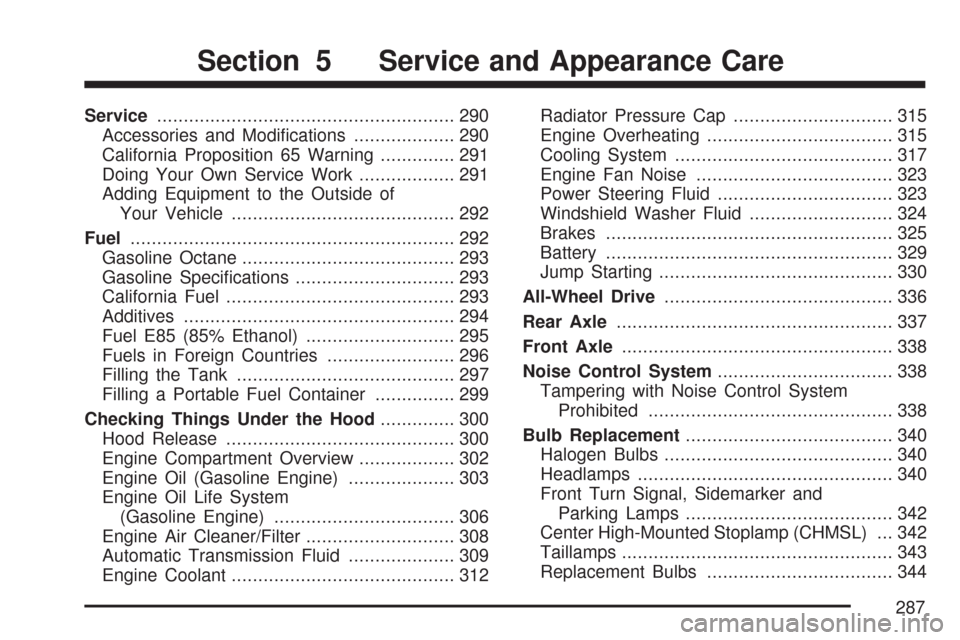
Service........................................................ 290
Accessories and Modifications................... 290
California Proposition 65 Warning.............. 291
Doing Your Own Service Work.................. 291
Adding Equipment to the Outside of
Your Vehicle.......................................... 292
Fuel............................................................. 292
Gasoline Octane........................................ 293
Gasoline Specifications.............................. 293
California Fuel........................................... 293
Additives................................................... 294
Fuel E85 (85% Ethanol)............................ 295
Fuels in Foreign Countries........................ 296
Filling the Tank......................................... 297
Filling a Portable Fuel Container............... 299
Checking Things Under the Hood.............. 300
Hood Release........................................... 300
Engine Compartment Overview.................. 302
Engine Oil (Gasoline Engine).................... 303
Engine Oil Life System
(Gasoline Engine).................................. 306
Engine Air Cleaner/Filter............................ 308
Automatic Transmission Fluid.................... 309
Engine Coolant.......................................... 312Radiator Pressure Cap.............................. 315
Engine Overheating................................... 315
Cooling System......................................... 317
Engine Fan Noise..................................... 323
Power Steering Fluid................................. 323
Windshield Washer Fluid........................... 324
Brakes...................................................... 325
Battery...................................................... 329
Jump Starting............................................ 330
All-Wheel Drive........................................... 336
Rear Axle.................................................... 337
Front Axle................................................... 338
Noise Control System................................. 338
Tampering with Noise Control System
Prohibited.............................................. 338
Bulb Replacement....................................... 340
Halogen Bulbs........................................... 340
Headlamps................................................ 340
Front Turn Signal, Sidemarker and
Parking Lamps....................................... 342
Center High-Mounted Stoplamp (CHMSL) ... 342
Taillamps................................................... 343
Replacement Bulbs................................... 344
Section 5 Service and Appearance Care
287
Page 337 of 458
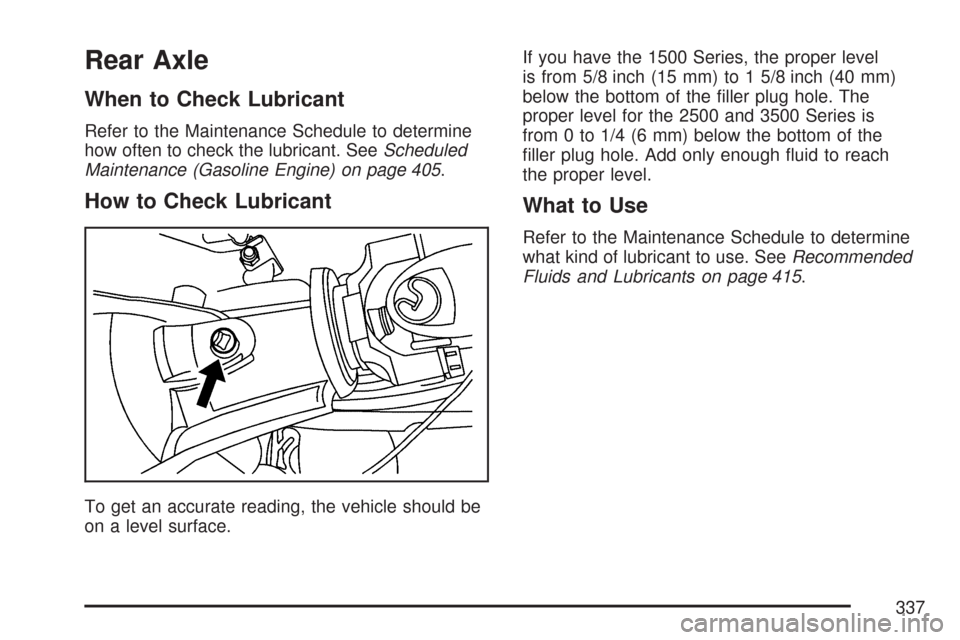
Rear Axle
When to Check Lubricant
Refer to the Maintenance Schedule to determine
how often to check the lubricant. SeeScheduled
Maintenance (Gasoline Engine) on page 405.
How to Check Lubricant
To get an accurate reading, the vehicle should be
on a level surface.If you have the 1500 Series, the proper level
is from 5/8 inch (15 mm) to 1 5/8 inch (40 mm)
below the bottom of the filler plug hole. The
proper level for the 2500 and 3500 Series is
from 0 to 1/4 (6 mm) below the bottom of the
filler plug hole. Add only enough fluid to reach
the proper level.
What to Use
Refer to the Maintenance Schedule to determine
what kind of lubricant to use. SeeRecommended
Fluids and Lubricants on page 415.
337
Page 352 of 458
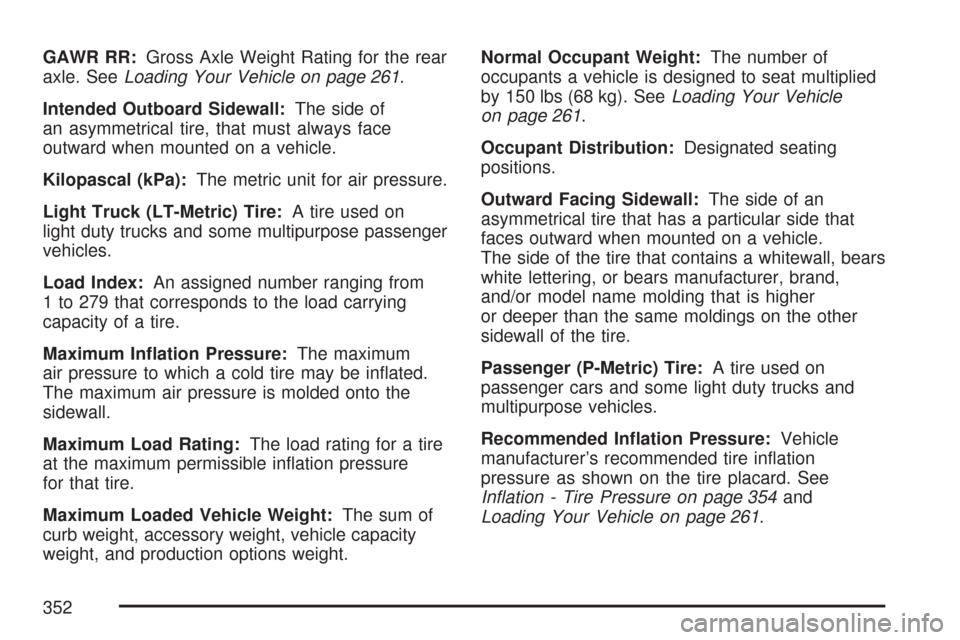
GAWR RR:Gross Axle Weight Rating for the rear
axle. SeeLoading Your Vehicle on page 261.
Intended Outboard Sidewall:The side of
an asymmetrical tire, that must always face
outward when mounted on a vehicle.
Kilopascal (kPa):The metric unit for air pressure.
Light Truck (LT-Metric) Tire:A tire used on
light duty trucks and some multipurpose passenger
vehicles.
Load Index:An assigned number ranging from
1 to 279 that corresponds to the load carrying
capacity of a tire.
Maximum In�ation Pressure:The maximum
air pressure to which a cold tire may be inflated.
The maximum air pressure is molded onto the
sidewall.
Maximum Load Rating:The load rating for a tire
at the maximum permissible inflation pressure
for that tire.
Maximum Loaded Vehicle Weight:The sum of
curb weight, accessory weight, vehicle capacity
weight, and production options weight.Normal Occupant Weight:The number of
occupants a vehicle is designed to seat multiplied
by 150 lbs (68 kg). SeeLoading Your Vehicle
on page 261.
Occupant Distribution:Designated seating
positions.
Outward Facing Sidewall:The side of an
asymmetrical tire that has a particular side that
faces outward when mounted on a vehicle.
The side of the tire that contains a whitewall, bears
white lettering, or bears manufacturer, brand,
and/or model name molding that is higher
or deeper than the same moldings on the other
sidewall of the tire.
Passenger (P-Metric) Tire:A tire used on
passenger cars and some light duty trucks and
multipurpose vehicles.
Recommended In�ation Pressure:Vehicle
manufacturer’s recommended tire inflation
pressure as shown on the tire placard. See
In�ation - Tire Pressure on page 354and
Loading Your Vehicle on page 261.
352
Page 364 of 458
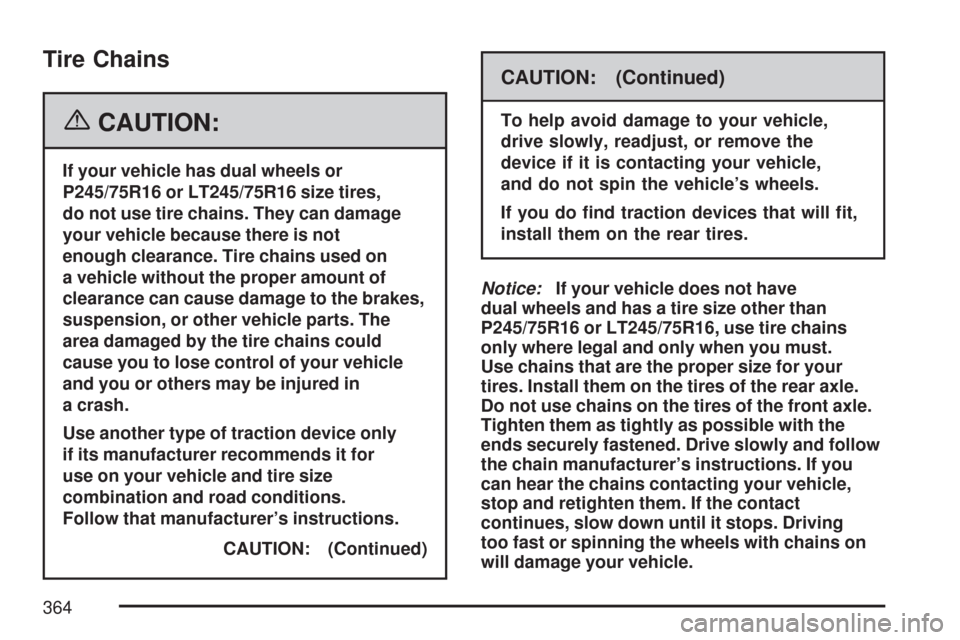
Tire Chains
{CAUTION:
If your vehicle has dual wheels or
P245/75R16 or LT245/75R16 size tires,
do not use tire chains. They can damage
your vehicle because there is not
enough clearance. Tire chains used on
a vehicle without the proper amount of
clearance can cause damage to the brakes,
suspension, or other vehicle parts. The
area damaged by the tire chains could
cause you to lose control of your vehicle
and you or others may be injured in
a crash.
Use another type of traction device only
if its manufacturer recommends it for
use on your vehicle and tire size
combination and road conditions.
Follow that manufacturer’s instructions.
CAUTION: (Continued)
CAUTION: (Continued)
To help avoid damage to your vehicle,
drive slowly, readjust, or remove the
device if it is contacting your vehicle,
and do not spin the vehicle’s wheels.
If you do �nd traction devices that will �t,
install them on the rear tires.
Notice:If your vehicle does not have
dual wheels and has a tire size other than
P245/75R16 or LT245/75R16, use tire chains
only where legal and only when you must.
Use chains that are the proper size for your
tires. Install them on the tires of the rear axle.
Do not use chains on the tires of the front axle.
Tighten them as tightly as possible with the
ends securely fastened. Drive slowly and follow
the chain manufacturer’s instructions. If you
can hear the chains contacting your vehicle,
stop and retighten them. If the contact
continues, slow down until it stops. Driving
too fast or spinning the wheels with chains on
will damage your vehicle.
364